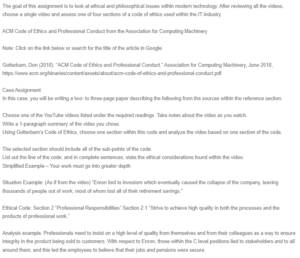Code of Ethics – Case of Self-Driving Cars
In the video, the narrator notes the ethical dilemma associated with self-driving cars. The ethical dilemma involves the various decisions made by self-driving cars, where the safety of an individual, as well as the safety of other motorists, is involved. From the video, an example of the various decisions that a self-driving car can make during an accident is provided. These decisions include choosing not to harm other motorists at the expense of the passenger, or choosing to save the passenger from an accident and opting to harm other motorists. In such instances, an ethical dilemma arises since the decision made by the self-driving car has to be predetermined by parties such as the programmer, the car manufacturing company, or even the government. Additionally, the question of whether the passenger of the self-driving car would opt to have the car choose to protect their lives at all costs, including at the expense of other motorists, or have the car choose to protect the lives of other motorists at the expense of the passenger’s life. Therefore, despite the various advantages provided by self-driving cars, the inevitable occurrence of accidents creates an ethical dilemma concerning the possible decisions made by self-driving cars (Du, 2015).
In the Code of Ethics by Gotterbam (2018), section 1.2 of the General Ethical Principles notes that computing professionals should avoid harm. In this case, harm is defined as the negative consequences that are likely to occur from various intentions. To avoid negative consequences, the potential impact of the intended actions has to be considered. While the occurrence of harm might be unintentional, minimizing its occurrence should be considered by adhering to the guidelines defined to reduce the occurrence of the incidents likely to cause harm. Under the Professional Responsibilities, section 2.5 of the Code of Ethics involves giving comprehensive and thorough evaluations of computer systems and the impact of the computer systems. This section of the Code of Ethics involves ensuring that analysis of the computer system notes the various possible issues that are likely to occur in the future after the implementation of the system. These issues include possible risks, and their identification should prompt the computing professional to notify the appropriate stakeholders.
Taking into consideration section 1.2, Avoid Harm of the Code of Ethics, a computing professional is required to ensure that the different negative consequences likely to occur are avoided. In the case of the video, this involves ensuring that the self-driving car does not cause harm. As noted in the video, the decision made by the self-driving car depends on the programmers, the car manufacturing company, and the government. On the aspect of the programmer, the programmer can choose to ensure that the car maintains the safety of the passenger at the expense of the other motorists. In this case, the programmer causes harm to other motorists to ensure the security of the passenger. Related to section 1.2, Avoid Harm of the Code of Ethics, section 2.5 involves an analysis of the potential risks in the computer system. In the case of self-driving cars, the analysis of the computer system used in self-driving cars should determine the possible decisions made by the car during an accident. Identification of the decision made by the car during the accident can be essential in mitigating the risk associated with the decision.
References
Du, Yukai. The Ethical Dilemma of Self-Driving Cars, YouTube, 8 Dec. 2015, www.youtube.com/watch?v=ixIoDYVfKA0
Gotterbam, Don. “ACM Code of Ethics and Professional Conduct.” Association for Computing Machinery, June 2018, https://www.acm.org/binaries/content/assets/about/acm-code-of-ethics-and-professional-conduct.pdf
ORDER A PLAGIARISM-FREE PAPER HERE
We’ll write everything from scratch
Question
The goal of this assignment is to look at ethical and philosophical issues within modern technology. After reviewing all the videos, choose a single video and assess one of four sections of a code of ethics used within the IT industry.

Code of Ethics – Case of Self-Driving Cars
ACM Code of Ethics and Professional Conduct from the Association for Computing Machinery
Note: Click on the link below or search for the title of the article in Google.
Gotterbam, Don (2018). “ACM Code of Ethics and Professional Conduct.” Association for Computing Machinery, June 2018, https://www.acm.org/binaries/content/assets/about/acm-code-of-ethics-and-professional-conduct.pdf
Case Assignment
In this case, you will be writing a two- to three-page paper describing the following from the sources within the reference section:
Choose one of the YouTube videos listed under the required readings. Take notes about the video as you watch.
Write a 1-paragraph summary of the video you chose.
Using Gotterbam’s Code of Ethics, choose one section within this code and analyze the video based on one section of the code.
The selected section should include all of the sub-points of the code.
List out the line of the code, and in complete sentences, state the ethical considerations found within the video.
Simplified Example – Your work must go into greater depth
Situation Example: (As if from the video) “Enron lied to investors which eventually caused the collapse of the company, leaving thousands of people out of work, most of whom lost all of their retirement savings.”
Ethical Code: Section 2 “Professional Responsibilities” Section 2.1 “Strive to achieve high quality in both the processes and the products of professional work.”
Analysis example: Professionals need to insist on a high level of quality from themselves and from their colleagues as a way to ensure integrity in the product being sold to customers. With respect to Enron, those within the C level positions lied to stakeholders and to all around them, and this led the employees to believe that their jobs and pensions were secure.

